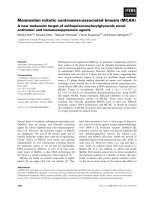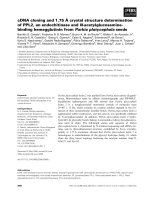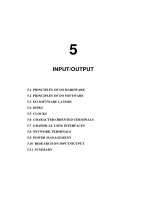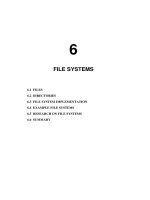A computer system consists of hardware, system programs, and application programs figs 11
Bạn đang xem bản rút gọn của tài liệu. Xem và tải ngay bản đầy đủ của tài liệu tại đây (445.14 KB, 46 trang )
11
CASE STUDY 2: WINDOWS 2000
11.1 HISTORY OF WINDOWS 2000
11.2 PROGRAMMING WINDOWS 2000
11.3 SYSTEM STRUCTURE
11.4 PROCESSES AND THREADS IN WINDOWS 2000
11.5 MEMORY MANAGEMENT
11.6 INPUT/OUTPUT IN WINDOWS 2000
11.7 THE WINDOWS 2000 FILE SYSTEM
11.8 SECURITY IN WINDOWS 2000
11.9 CACHING IN WINDOWS 2000
11.10 SUMMARY
Item Windows 95/98 Windows NT
Full 32-bit system? No Yes
Security? No Yes
Protected file mappings? No Yes
Private addr space for each
MS-DOS prog? No Yes
Unicode? No Yes
Runs on Intel 80x86 80x86, Alpha, MIPS,
Multiprocessor support? No Yes
Re-entrant code inside OS? No Yes
Plug and play? Yes No
Power management? Yes No
FAT-32 file system? Yes Optional
NTFS file system No Yes
Win32 API? Yes Yes
Run all old
MS-DOS programs? Yes No
Some critical OS data writable by user? Yes No
Fig. 11-1. Some differences between Windows 98 and Windows
NT.
Version Max RAM CPUs Max clients Cluster size Optimized for
Professional 4 GB 2 10 0 Response time
Server 4 GB 4 Unlimited 0 Throughput
Advanced server 8 GB 8 Unlimited 2 Throughput
Datacenter server 64 GB 32 Unlimited 4 Throughput
Fig. 11-2. The different versions of Windows 2000.
Year AT&T BSD MINIX Linux Solaris Win NT
1976 V6 9K
1979 V7 21K
1980 4.1 38K
1982 Sys III 58K
1984 4.2 98K
1986 4.3 179K
1987 SVR3 92K 1.0 13K
1989 SVR4 280K
1991 0.01 10K
1993 Free 1.0 235K 5.3 850K 3.1 6M
1994 4.4 Lite 743K 1.0 165K 3.5 10M
1996 2.0 470K 4.0 16M
1997 2.0 62K 5.6 1.4M
1999 2.2 1M
2000 Free 4.0 1.4M 5.8 2.0M 2000 29M
Fig. 11-3. A comparison of some operating system sizes. The first
string in each box is the version; the second is the size measured in
lines of source code, where K = 1000 and M = 1,000,000. Com-
parisons within a column have real meaning; comparisons across
columns do not, as discussed in the text.
Win32
application
program
Win32 Application Programming Interface
Win32s
Windows 3.x Windows NT Window 2000
Windows
95/98/Me
Fig. 11-4. The Win32 API allows programs to run on almost all
versions of Windows.
Key Description
HKEY LOCAL MACHINE Properties of the hardware and software
HARDWARE Hardware description and mapping of hardware to drivers
SAM Security and account information for users
SECURITY System-wide security policies
SOFTWARE Generic information about installed application programs
SYSTEM Information for booting the system
HKEY USERS Information about the users; one subkey per user
USER-AST-ID User AST’s profile
AppEvents Which sound to make when (incoming email/fax, error, etc.)
Console Command prompt settings (colors, fonts, history, etc.)
Control Panel Desktop appearance, screensaver, mouse sensitivity, etc.
Environment Environment variables
Keyboard Layout Which keyboard: 102-key US, AZERTY, Dvorak, etc.
Printers Information about installed printers
Software User preferences for Microsoft and third party software
HKEY PERFORMANCE DATA Hundreds of counters monitoring system performance
HKEY CLASSES ROOT Link to HKEY LOCAL MACHINE\SOFTWARE\CLASSES
HKEY CURRENT CONFIG Link to the current hardware profile
HKEY CURRENT USER Link to the current user profile
Fig. 11-5. The root keys registry keys and selected subkeys. The
capitalization has no meaning but follows the Microsoft practice
here.
Win32 API function Description
RegCreateKeyEx Create a new registry key
RegDeleteKey Delete a registry key
RegOpenKeyEx Open a key to get a handle to it
RegEnumKeyEx Enumerate the subkeys subordinate to the key of the handle
RegQueryValueEx Look up the data for a value within a key
Fig. 11-6. Some of the Win32 API calls for using the registry
POSIX program
POSIX subsystem
Win32 program
Win32 subsystem
OS/2 program
OS/2 subsystem
Service
process
System interface (NT DLL.DLL)
System services
Hardware
Hardware Abstraction layer (HAL)
Kernel
File sys
I/O mgr
Object
mgr
Process
mgr
Memory
mgr
Security
mgr
Cache
mgr
PnP
mgr
Power
mgr
Config
mgr
LPC
mgr
Win32
GDI
Video
driver
D
Kernel mode User mode
Fig. 11-7. The structure of Windows 2000 (slightly simplified).
The shaded area is the executive. The boxes indicated by D are
device drivers. The service processes are system daemons.
Device
registers
Device
addresses
Interrupts
DMA Timers
Spin
locks
BIOS
Disk
RAM
Printer
1.
2.
3.
MOV EAX,ABC
ADD EAX,BAX
BNE LABEL
MOV EAX,ABC
MOV EAX,ABC
ADD EAX,BAX
BNE LABEL
MOVE AX,ABC
ADD EAX,BAX
BNE LABEL
Hardware abstraction layer
Fig. 11-8. Some of the hardware functions the HAL manages.
Object
header
Object
data
Object-specific data
Object name
Directory in which the object lives
Security information (which can use object)
Quota charges (cost to use the object)
List of processes with handles
Reference counts
Pointer to the type object
Type name
Access types
Access rights
Quota charges
Synchronizable?
Pageable
Open method
Close method
Delete method
Query name method
Parse method
Security method
Fig. 11-9. The structure of an object.
Type Description
Process User process
Thread Thread within a process
Semaphore Counting semaphore used for interprocess synchronization
Mutex Binary semaphore used to enter a critical region
Event Synchronization object with persistent state (signaled/not)
Port Mechanism for interprocess message passing
Timer Object allowing a thread to sleep for a fixed time interval
Queue Object used for completion notification on asynchronous I/O
Open file Object associated with an open file
Access token Security descriptor for some object
Profile Data structure used for profiling CPU usage
Section Structure used for mapping files onto virtual address space
Key Registry key
Object directory Directory for grouping objects within the object manager
Symbolic link Pointer to another object by name
Device I/O device object
Device driver Each loaded device driver has its own object
Fig. 11-10. Some common executive object types managed by
object manager.
Thread
1
Mutex
1
Mutex
2
Mutex
3
Thread
2
Thread
3
Thread
4
Thread
type
object
Mutex
type
object
Handle
table for
process A
Handle
table for
process B
1010
1011
1110
1111
0101
Fig. 11-11. The relationship between handle tables, objects, and
type objects.
Directory Contents
?? Starting place for looking up
MS-DOS devices like C:
Device All discovered I/O devices
Driver Objects corresponding to each loaded device driver
ObjectTypes The type objects shown in Fig. 11-11
Windows Objects for sending messages to all the windows
BaseNamedObjs User-created objects such as semaphores, mutexes, etc.
Arcname Partition names discovered by the boot loader
NLS National language support objects
FileSystem File system driver objects and file system recognizer objects
Security Objects belonging to the security system
KnownDLLs Key shared libraries that are opened early and held open
Fig. 11-12. Some typical directories in the object name space.
Gdi32.dll
User32.dll
Kernel32.dll
Call
Call
Call
Operating system
User
process
2a
3a
2b
3b
4b
System interface (ntdll.dll)
Enviroment
subsystem
process
(csrss.exe)
Win32
subsys
1
User
space
Kernel
space
Fig. 11-13. Various routes taken to implement Win32 API func-
tion calls.
File Mode Fcns Contents
hal.dll Kernel 95 Low-level hardware management, e.g., port I/O
ntoskrnl.exe Kernel 1209 Windows 2000 operating system (kernel + executive)
win32k.sys Kernel - Many system calls including most of the graphics
ntdll.dll User 1179 Dispatcher from user mode to kernel mode
csrss.exe User 0 Win32 environment subsystem process
kernel32.dll User 823 Most of the core (nongraphics) system calls
gdi32.dll User 543 Font, text, color, brush, pen, bitmap, palette, drawing, etc. calls
user32.dll User 695 Window, icon, menu, cursor, dialog, clipboard, etc. calls
advapi32.dll User 557 Security, cryptography, registry, management calls
Fig. 11-14. Some key Windows 2000 files, the mode they run in,
the number of exported function calls, and the main contents of
each file. The calls in win32k.sys are not formally exported since
win32k.sys is not called directly.
Name Description
Job Collection of processes that share quotas and limits
Process Container for holding resources
Thread Entity scheduled by the kernel
Fiber Lightweight thread managed entirely in user space
Fig. 11-15. Basic concepts used for CPU and resource manage-
ment.
Address
space
Thread
Process
User
stack
Kernel mode thread stack
Access token
Process
handle
table
P
T
T
T
T
P
Job
Fig. 11-16. The relationship between jobs, processes, and threads.
Several fibers can also be multiplexed on one thread (not shown).
Win32 API Function Description
CreateProcess Create a new process
CreateThread Create a new thread in an existing process
CreateFiber Create a new fiber
ExitProcess Terminate current process and all its threads
ExitThread Terminate this thread
ExitFiber Terminate this fiber
SetPriorityClass Set the priority class for a process
SetThreadPriority Set the priority for one thread
CreateSemaphore Create a new semapahore
CreateMutex Create a new mutex
OpenSemaphore Open an existing semaphore
OpenMutex Open an existing mutex
WaitForSingleObject Block on a single semaphore, mutex, etc.
WaitForMultipleObjects Block on a set of objects whose handles are given
PulseEvent Set an event to signaled then to nonsignaled
ReleaseMutex Release a mutex to allow another thread to acquire it
ReleaseSemaphore Increase the semaphore count by 1
EnterCriticalSection Acquire the lock on a critical section
LeaveCriticalSection Release the lock on a critical section
Fig. 11-17. Some of the Win32 calls for managing processes,
threads, and fibers.
Win32 process class priorities
Above Below
Realtime High Normal Normal Normal Idle
Time critical 31 15 15 15 15 15
Highest 26 15 12 10 8 6
Win32 Above normal 25 14 11 9 7 5
thread Normal 24 13 10 8 6 4
priorities Below normal 23 12 9 7 5 3
Lowest 22 11 8 6 4 2
Idle 1611111
Fig. 11-18. Mapping of Win32 priorities to Windows 2000 priori-
ties.
Next thread to run
Priority
System
priorities
User
priorities
Zero page thread
31
24
16
8
1
0
Idle thread
Fig. 11-19. Windows 2000 supports 32 priorities for threads.
12
4
8
12
Does a down on the
semaphore and blocks
Semaphone
Semaphone
Blocked
Running
Ready
Waiting on the semaphore
Would like to do an up
on the semaphore but
never gets scheduled
(a) (b)
Fig. 11-20. An example of priority inversion.
Process
MS–DOS program
1
2
3
4Trampoline
Operating system
Ntvdm
Fig. 11-21. How old MS-DOS programs are run under Windows
2000.
Process Description
idle Not really a process, but home to the idle thread
system Creates smss.exe & paging files; reads registry; opens DLLs
smss.exe First real proc; much initialization; creates csrss & winlogon
csrss.exe Win32 subsystem process
winlogon.exe Login daemon
lsass.exe Authentication manager
services.exe Looks in registry and starts services
Printer server Allows remote jobs to use the printer
File server Serves requests for local files
Telnet daemon Allows remote logins
Incoming email handler Accepts and stores inbound email
Incoming fax handler Accepts and prints inbound faxes
DNS resolver Internet domain name system server
Event logger Logs various system events
Plug-and-play manager Monitors hardware to see what is out there
Fig. 11-22. The processes starting up during the boot phase. The
ones above the line are always started. The ones below it are
examples of services that could be started.
Process A
4 GB
2 GB
0
Nonpaged pool
Paged pool
A's page tables
Stacks, data, etc
HAL + OS
System data
Process A's
private code
and data
Process B
Nonpaged pool
Paged pool
B's page tables
Stacks, data, etc
HAL + OS
System data
Process B's
private code
and data
Process C
Nonpaged pool
Paged pool
C's page tables
Stacks, data, etc
HAL + OS
System data
Process C's
private code
and data
Bottom and top
64 KB are invalid
Fig. 11-23. Virtual address space layout for three user processes.
The white areas are private per process. The shaded areas are
shared among all processes.
Process A Process B
Backing store on disk
Paging file
Lib.dll
Prog1.exe Prog2.exe
Program
Program
Shared
library
Shared
library
Data
Stack
Stack
Data
Region
Fig. 11-24. Mapped regions with their shadow pages on disk. The
lib.dll file is mapped into two address spaces at the same time.









